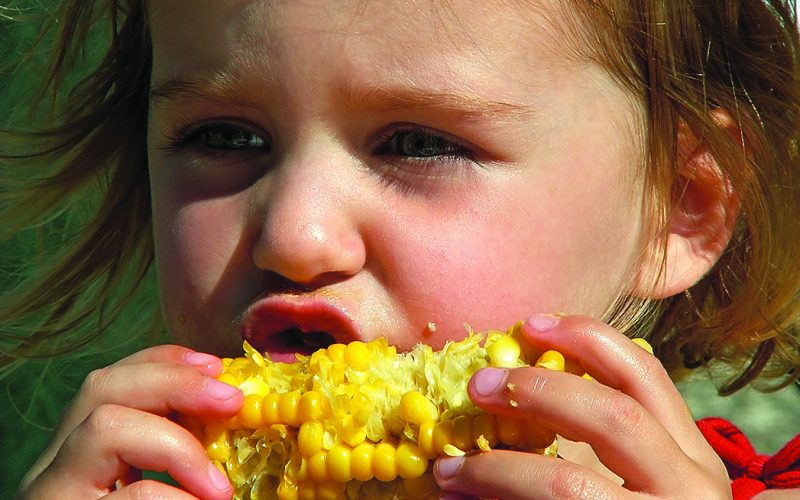In A Store Near You
Do you ever wonder what’s in your food? This might be food that comes in a box or can or it could even be “fresh produce.” Now, if you are at the store holding a can or box it’s simple enough to turn the package around and look over the ingredients. This is a good exercise. It’s nice to see a succinct list of ingredients you recognize. But don’t stop here. What about all those ingredients? What’s in them? And the fruits and vegetables over in Produce. We are what we eat, and same goes for the animals, so what do they eat and then pass up the food chain to us? A lot of times they eat grains, so what’s in those grains?
All of these questions and more are important when discussing “GMOs,” a well-known acronym that stands for Genetically Modified Organisms. Mainly because nowadays, they’re everywhere.
“According to the Grocery Manufacturing Association, 70 percent of items in American food stores contain genetically modified organisms.”(1) An estimated 80 percent of processed food contains GMOs. That’s a lot. And the sad thing is we aren’t even aware when confronted with an item at the store. A stroll through the grocery isle shouldn’t be a mystery walk, with the occasional revelation of finding an organic or ‘Non-GMO Project’ product.
GMO’s Around The World
GMO’s are in the news a lot these days, and the stories cross many political and country boundaries leaving a revealing picture of how much is left to be discovered about the potential merits of genetically-modified food.
The arguments in favor of GMO’s are powerful. Genes can be modified for resistance against pests and diseases, possibly decreasing the need for pesticides sprayed onto plants. Instead, the resistance is built into the seed. This occurs in maize, cotton and potatoes. Seeds can be altered to be hardier and stand up to increased heat or drought, of which we are going to see increased amounts. Crops can be engineered to grow faster, or for fruits and veggies to more slowly ripen. These are significant selling points, and I don’t make light of them. For a planet with a global population now topping 7 billion, and set to top 9 billion by 2050, feeding every one of us is of utmost concern. Considered alongside land resources and water security these are major topics facing every single country, on a planet that is only getting smaller.
So it is very significant when countries start rethinking their policies around GMO’s. And that’s what is happening. The European Union has regulated the labeling of GM food since 1997. This has had a positive knock-on effect of consumers demanding less GM food. On Jan. 28, Poland became the eighth European country to ban the cultivation of European Union-approved genetically modified crops. The two crops in question here are Monsanto’s MON810 maize and BASF’s Amfiora potato. Poland’s Ministry of Agriculture is concerned that the GM (genetically modified) crops will cross-pollinate with non-GM crops. The BASF maize has come under so much fire in Europe that BASF has said they will pull it from that market and focus on less restrictive markets like the USA.
There was high-profile news last fall when Russia banned all GM corn based on research showing the development of cancer. The GM corn comes from GMO giant Monsanto, based out of the St. Louis region.
Similar stories of countries either banning GM crops or scientific communities asking their governments to do more research into them are everywhere, including Thailand, the Philippines and India. Many countries and communities are rethinking their agricultural roadmaps and pursuing more innovative and sustainable farming practices.
A great example that came out in the past week shows a village in one of India’s poorest states, Bihar, growing world-record amounts of rice using no GM crops or herbicides. On one hectare of land, 22.4 metric tons of rice were grown beating the previous Chinese record of 19.4. It is these kinds of examples that farmers want to hear about and take lessons from.(2)
The health concern of food from GMO’s is one part of the issue, a part that is hotly contested and slow to unfold. The other side of the issue is the farming of GM crops. Ownership of seeds, along with cross-pollination of GM crops with non-GM crops, are the biggest agricultural battle of the 21st century.
It is estimated that half of the world’s seed industry — and over 80 percent of American commodity crops — are now in the hands of a very small, powerful group of manufacturers like Monsanto, Bayer, Dow and DuPont that control the GM crops. These corporations have created a type of captive market they are in control of. Many GM seeds require a special type of pesticide. The pest deterrent isn’t necessarily built into the seed; rather, these companies seek to make larger profits by building seeds that only work alongside their pesticides.
How about the thought of a “suicide gene” which makes seeds sterile after one season? Monsanto owns the patent on this. They are saying it won’t be used but farmers — along with many skeptics — remain concerned.
Battles with Monsanto are now just part of life for American and worldwide farmers.
The Beginning Of A Dynasty
It started in the 1980s when Monsanto’s patented soybean that works in tandem with their pesticide Round-Up took off like wildfire with many U.S. farmers. Native soybean varieties all over the country have been infected since making seed saving difficult and polluting countless fields of farmers who weren’t using the Round-Up seeds and now have them. In cases like this, Monsanto has taken to suing those farmers for using their seeds, and also restricting the ability of farmers to save seeds year after year — a practice as old as agriculture. Even organic farmers who do want GM seeds finds it’s nearly impossible to completely remove, especially the heavily used crops like soybeans and corn.
On Feb. 19, the Supreme Court took over a high profile case of Indiana farmer Vernon Hugh Bowman’s argument against Monsanto. The claim is that Monsanto lost the right to keep him from planting Roundup Ready soybean seeds he bought from a grain elevator. The seeds came from soybean growers who had harvested and sold second-generation seed to the elevator, which in turn sold them to Bowman. Monsanto is claiming they have rights to the seeds still. When do such GM seed rights end?
The case has correlation to many battles that our American farmers have been waging and losing for some time now and the decision is likely to prove helpful or dire for the likelihood of future farming in this country. Bowman has the support of the National Farmers Union, Center for Food Safety, American Antitrust Institute, the Automotive Aftermarket Industry Association and the Public Patent Foundation. The groups say a court decision in favor of Monsanto will give patent holders undue control in the distribution and use of their products. Competition, they argue, will suffer.(3)
The need to label GM food is, indeed, multi-faceted. Doing so will bring much needed light to all dimensions of 21st century agriculture. So far, the Food & Drug Administration and USDA have balked at the initiative to label our food. The influence coming from political contributions from companies like Monsanto are huge and aimed at making sure they stay in control.
Industry Control In Politics
On the campaign trail in 2007, Obama spoke in strong terms about moving forward with GMO labeling. Instead, companies like Monsanto strong-armmed the USDA to pass more GMO crops.
Currently there are 13 new GMO crops awaiting approval, along with a GM salmon. Just like the crops, the salmon wouldn’t be labeled and when you go to buy salmon, you’d have no way of knowing you are eating the “frankensalmon” that is impacting natural salmon stocks.
It is hard to measure the health risks to us by eating GM food because there is no labeling. If there was labeling, connections would start being made by physicians between the diets of their patients and the sicknesses. This is yet another reason why companies profiting from GMO’s are working so hard to keep labels off the food. This played out vividly in California last year. Proposition 37 was a highly publicized effort to set a new precedence in the country and start labeling anything that is genetically modified. This extends all the way to meat if the animal is fed GM crops. It also required a re-evaluation of anything labeled “natural” to meet strict requirements. Had this proposition gone through the dominos would start to fall and more and more states would follow suit. The proposition failed ultimately, with no help from the roughly $40 million spent opposing it. Big contributors included Monsanto (over $7 million), Pepsico (over $2 million), Kraft, Nestle, Coca-Cola (all over $1 million).
The Ongoing Struggle
California will continue to fight, and next time such a proposition will pass — this last one lost by less than 3 percent. Citizens are becoming more educated and interested in the battle — “What’s in my food?” “What’s happening to our farmers?” More states are starting propositions to get their food labeled. We need to do so here in Arkansas.
Genetically-modified crops are still brand new territory. Scientists now have thirty years worth of experimenting and testing with this process. Compare that to nature fine-tuning crops that hundreds of generations of human beings have been depending on since the earliest agrarian cultures. Even at that time, nature had a head start of tens, if not hundreds, of millions of years adapting crops to their environments and paving a bountiful harvest that we just need to rediscover.
1. http://www.forbes.com/sites/rachelhennessey/2012/11/03/gmo-food-debate-in-the-national-spotlight/
2. http://www.guardian.co.uk/global-development/2013/feb/16/india-rice-farmers-revolution?CMP=twt_gu
3. http://www.rollcall.com/news/farmers_use_of_modified_seeds_reaches_supreme_court-222292-1.html?pg=1












